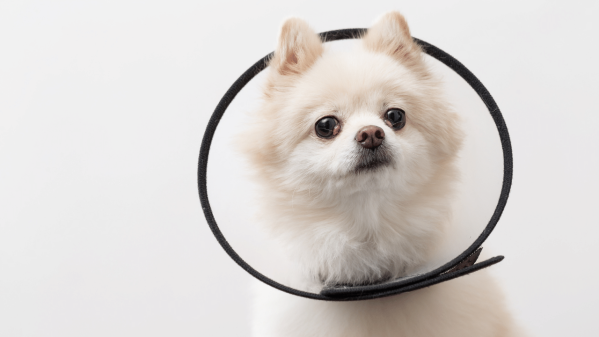Spaying or neutering your dog is something that almost all veterinarians recommend — not only does it help mitigate pet homelessness, but it also reduces certain health risks for your dog. Setting up a surgical procedure for your dog, however, can understandably raise a lot of questions: How long will recovery take? How should you care for your pup post-surgery? And what is spaying and neutering exactly?
Read on to learn more about spaying or neutering a dog and what it means for your pup’s health.
What is spaying/neutering a dog? What's the difference?
Spaying or neutering your dog makes them unable to procreate — something that’s important for reducing the number of homeless pups out there. The most common method for spaying or neutering your dog involves surgical sterilization, where your veterinarian removes certain reproductive organs from your pup.
Female dogs are spayed and, according to the American Veterinary Medical Association (AVMA), the most common procedure is an ovariohysterectomy, where a dog’s ovaries, fallopian tubes, and uterus are removed. Male dogs are neutered, and undergo an orchiectomy, where their testes are removed.
According to Dr. Elizabeth Lynch, staff veterinarian at MSPCA at Nevins Farm, both spay and neuter procedures are done under general anesthesia with your pup fully asleep. Your dog is also given some medication before going under to provide additional pain relief.
Read More: What Can I Give My Dog For Pain?
How does spaying work in dogs?
For female pups who are spayed: Your veterinarian will make an incision just below their belly button and remove the ovaries, fallopian tubes, and uterus from there. Your vet will then close the incision with stitches under the skin that will dissolve and then close the external part of the skin with staples, glue, or stitches. The procedure can take anywhere from 20 to 90 minutes, depending on the dog’s age, size, and whether they’re in heat (dogs in heat take longer).
How does neutering work in dogs?
For male pups who are neutered: your veterinarian will make an incision near the scrotum and will remove the testicles through that incision. The vet will then close the incision with stitches under the skin and then close the external part of the skin with glue, staples, or stitches. The procedure takes 5 to 20 minutes.
When should a dog be spayed/neutered?
According to the American Animal Hospital Association (AAHA), small-breed dogs (projected to be under 45 pounds when fully grown) should be neutered at 6 months of age or spayed prior to their first heat, which usually occurs at around 5 or 6 months.
Dogs projected to be over 45 pounds when fully grown should be neutered after growth stops, which can be between 9 to 15 months old. Large female dogs can be spayed anywhere between 5 to 15 months depending on multiple factors that your veterinarian will discuss with you.
Should you spay/neuter your dog?
Yes. Spaying and neutering your dog not only helps mitigate pet homelessness, but it can also have medical benefits for your pup. According to the American Society for the Prevention of Cruelty to Animals (ASPCA), spaying your female dog will help prevent uterine infections and breast tumors, and neutering male dogs helps prevent testicular cancer and prostate problems.
How much does spaying/neutering a dog cost?
Depending on where you live, there are several organizations like the ASPCA that offer free or low-cost spaying and neutering services. Wherever you get the procedure done, however, make sure you’re comfortable with the facility and that you give your pup veterinary care before and afterwards to make sure they receive the medical attention they need.
Read More: How Much Does The Vet Cost?
Do dogs still go into heat after being spayed/neutered?
No. Estrogen, which is produced in the ovaries, is what makes female dogs go into heat. Spaying your dog removes their ovaries, so your dog will not go into heat.
Read More: What To Know About Dog Pregnancy, Heat & Prenatal Health
How long does it take a dog to recover from spaying/neutering?
The ASPCA says it takes seven to 10 days for your dog to fully recover.
How to care for your dog after spaying/neutering
Limit your dog's activity
In order to make their recovery as comfortable as possible, the ASPCA recommends you limit your dog’s activity while they’re recovering. This means no runs in the park, no swimming, and no other jumping or playing, something that admittedly may be easier said than done with a young dog.
Don't introduce any new food
The ASPCA also recommends not introducing new food to your dog during this time.
Keep the incision dry
Keep the incision dry (this includes NOT putting any topical ointment on it). You also may want to get a dog collar to keep your pup from licking it.
Monitor the incision for complications
It’s also important to keep an eye on your dog’s incision to make sure there aren’t any complications. “Some of the most common post-operative complications include inflammation or infection of the incision, opening up of the incision, swelling under the skin at the incision site caused by fluid, and bleeding,” Dr. Lynch explained on the MSPCA website. “These complications can be caused or made worse by the pet licking or chewing the skin at the incision or by not keeping the pet quiet as directed after surgery.”
If you keep an eye on your pup, however, chances are very good that your dog will be back to their old self in two weeks or so. The benefits from their surgery, however, will last their lifetime.
